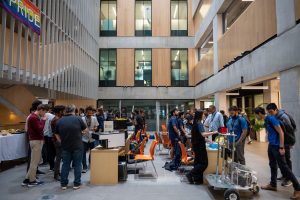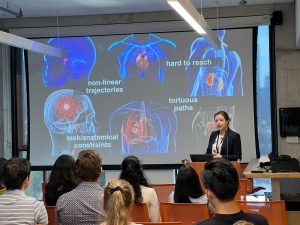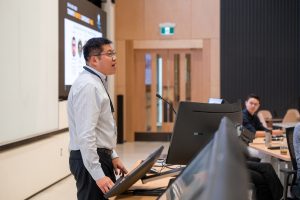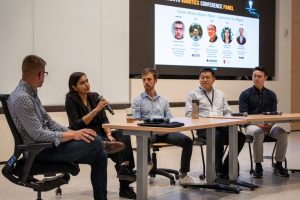
Over 200 industry partners, alumni, researchers and students gathered at the Myhal Centre for Engineering Innovation & Entrepreneurship for the sold out, first annual Toronto Robotics Conference. The conference was hosted by the University of Toronto Robotics Institute (Robotics Institute) and sponsored by Magna International, ClaroNav Inc. and OTTO Motors.
The two-day event held from July 18-19, showcased the cutting-edge mobility and healthcare research at the Robotics Institute, and provided a forum for collaboration and idea sharing among key stakeholders across the robotics ecosystem.
However, topics and discussions at the 2023 Toronto Robotics Conference were not limited to technical advancements. Attendees had the opportunity to hear from experts in a diversity of fields—from cybersecurity and career development to sidewalk robots and entrepreneurship.
Conference programming was divided into two core themes, career and research, with invited speakers from a variety of disciplines. In his opening remarks, Professor Eric Diller, conference co-chair with Professor Steve Waslander, highlighted that:
“It is important we consider the broader implications of our work, including policy, politics, regulations and risks. That’s why we took a different approach to our research conference this year—we wanted to offer a range of perspectives and create a space to think critically about how these pieces work together to move the sector forward.”
Addressing today’s pressing challenges with robotics solutions

Healthcare and mobility robotics are two fast-emerging areas of importance as industry and government look to increase the safety of autonomous vehicles and find new ways to optimize Canada’s healthcare system.
Faculty and graduate student speakers shared the many ways they’re addressing these pressing challenges with robotics solutions. These were shared during a series of faculty and student expert talks, including research talks from HeRo and WinTOR trainees.
HeRo trainees shared highlights of their healthcare robotics research, ranging from using socially assistive robots to support older adults in long-term care to using AI to boost the success of in vitro fertilization. WinTOR trainees presented on mobility research ranging from developing a traffic light detection and tracking system for autonomous vehicles (AVs) to preparing AVs for all-weather driving.
Attendees also heard from 10 Robotics Institute experts across healthcare and mobility on the grand challenges they’re solving in their labs—ranging from wearable robotics for stroke recovery to continuum robots for minimally invasive surgery and optimizing AVs for winter driving.
In addition to research talks, attendees were able to learn more and interact with Robotics Institute research through faculty lab demos and student posters.
Conference highlights breadth of robotics careers and opportunities for students

For graduate students looking to make the transition from academia to industry, the conference featured informational career presentations and panel discussions with alumni, as well as experts and founders from the U of T entrepreneurship ecosystem. These discussions showcased the diverse career pathways available after graduate studies, as well as strategies to help students navigate their future careers.
The Magna International Career Moves Alumni Panel focused on key skills that could help prepare graduate students to transition into industry. This included: making meaningful social connections, problem solving and learning how to translate graduate research into marketable job experience.

On the entrepreneurship panel moderated by director of U of T Entrepreneurship, Jon French, attendees heard from a range of early-career founders, including Chloë Ryan, CEO and founder of Acrylic Robotics, Robert Brooks, CEO and founder of ForceN, and Pooja Viswanathan, co-founder and CEO of Braze Mobility, who provided insights into how to get started as a robotics entrepreneur. Two key takeaways from the session included focusing on mental health and finding accelerator programs that best address the company’s unique needs.
Creating a meeting place for knowledge transfer
When designing a new technology for public use, many aspects need to be considered to benefit and address the needs of its users. This includes cybersecurity and policy considerations—two of the hot topics discussed with expert panelists during the conference.
The conference opened with a presentation on cybersecurity, led by U of T’s chief information security officer Isaac Straley. He highlighted the importance of an ever-changing landscape of technology, and the importance of building security into all facets of robotics at the outset of design instead of modifying later to meet industry and government requirements. This sentiment was echoed by panelist Neel Dayal, senior director, innovation and partnerships at Rogers Communication, during the panel discussion moderated by Professor Igor Gilitschensky.
Micro-utility devices (MUDs), also known as sidewalk robots, are another hot topic in robotics that was discussed at the conference. The panel, moderated by Professor Steve Waslander, explored key angles of policy development and consideration with representatives from the accessibility community, nonprofit and government weighing in.
Panelist Varun Chandak, founder and president of Access to Success, discussed the importance of designing for the edge user from the outset to best address the needs of all users. Panelist and executive director of the Urban Robotics Foundation, Bern Grush, highlighted how his team is working to educate both robotics companies and the public about how MUDs impact a city’s systems and population.
Panelist Charissa Iogna, project manager at the City of Toronto, provided insight into the ban of sidewalk robots in Toronto and what next steps look like for regulating the technology more broadly. This includes ongoing research and testing through transportation innovation zones, and developing municipal policies that align with the province’s framework which is still in development.
The panel ended on an optimistic note—panelists assured the audience they are working to strategically and safely introduce these new technologies in a way that benefits all community members and stakeholder groups.
A growing interdisciplinary community
The Toronto Robotics Conference is only one example of how robust the Toronto robotics community is. With stakeholders across industries, the sector is poised to help address our most pressing challenges, with healthcare and mobility being only two of the many ways robotics can be integrated into our everyday lives for the better.
